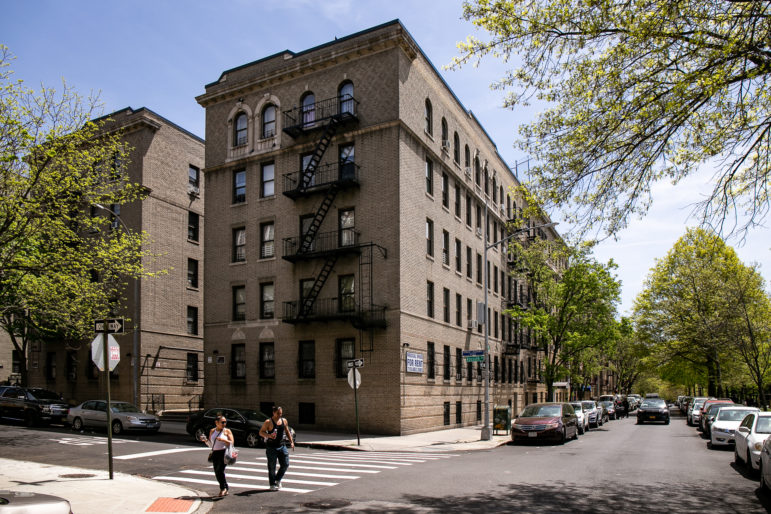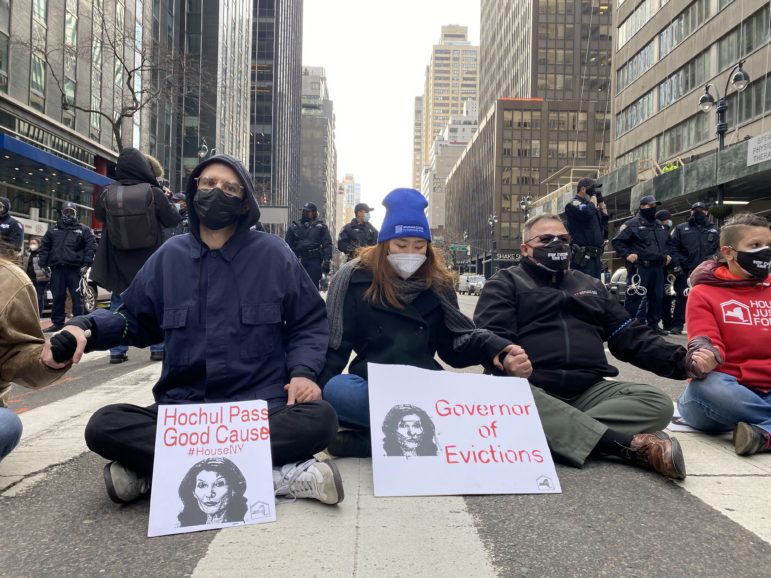Throughout the five boroughs and across the rental market, apartment prices continue to surge, according to an analysis of nearly 390,000 listings over the past three years that online marketplace StreetEasy shared with City Limits.

Adwar
A residential building with rent-stabilized apartments in The Bronx.This story was produced by student reporters in the City Limits Accountability Reporting Initiative For Youth (CLARIFY). With additional reporting by Genesis Castro, Rebecca Sampson, Marco Estrada and Zoe Martinez.
Lea la versión en español aquí.
When the average rent in Manhattan topped $5,000 earlier this year, the statistic became shorthand for an out-of-control market fueling bidding wars and pricing out tenants. But throughout the five boroughs and across the rental market, apartment prices continue to surge, according to an analysis of nearly 390,000 listings over the past three years by online marketplace StreetEasy shared with City Limits.
The median rent for a one-bedroom apartment in New York City spiked to $3,267 in August, up 20 percent from three years earlier, the data shows. For a two-bedroom, the median rent reached $3,804 last month—a nearly 27 percent increase from August 2019.
The StreetEasy analysis honed in on median asking rents for one- and two-bedroom apartments in each borough for the month of August for the past four years. The results revealed a hefty spike in median rents in all but Staten Island over that time period, though that may be due to sample size. Only 736 listings—about 0.2 percent of the total—were located in the southernmost borough.
In Queens, the median rent for a one-bedroom reached $2,299 last month, a 17 percent increase since August 2019. Two-bedrooms in the World’s Borough are up by nearly 15 percent over that period, reaching $2,750. In The Bronx, the median rents for a one-bedroom rose 14 percent from $1,650 in August 2019 to $1,900 last month. Two-bedrooms increased by 20 percent from $2,000 to $2,400.
In Brooklyn, the median rent for a two-bedroom went up 26.4 percent last month compared to August 2019—from $2,650 to $3,350, StreetEasy found. Brooklyn one-bedrooms have increased from $2,745 in August 2019 to $3,000 last month.
“Now I pay more for the same,” Ana Tejeda, who lives in Park Slope, said in Spanish in her response to an online survey conducted by City Limits’ youth journalism interns about how rent increases are impacting residents.
Natalio Martinez Cirizo, a food vendor who lives in Jackson Heights, Queens, said his rent has gone up $400 over the last several months. “If the landlord wants to raise the rent, I have to pay or leave,” he told a reporter in Spanish.
The citywide median rent increase compiled by StreetEasy over the past three years outpaced the rise in gross rent—rent plus utilities—in non-regulated apartments over the entire decade between 2009 and 2019, according to data from New York University’s Furman Center. The median gross rent citywide in that span rose by 16.3 percent in 2021 dollars, the Furman Center found.
The dramatic hikes take a toll on families, said Carla Marie Davis, 30, who spent much of her childhood moving from one Brooklyn apartment to the next as rents went up. Eventually, the prices forced most of her family to leave.
“High rents have completely torn apart communities,” she said. “It’s insane. We need to fix it.”
Davis, a TikTok star, has used her social media platform to advocate for stronger tenant protections, including Good Cause Eviction legislation that would give renters in unregulated units a right to a lease renewal in most circumstances. The legislation would also allow tenants to challenge exorbitant increases in court, where the landlord would then have to provide justification.
That measure, opposed by the real estate industry and landlord groups, failed in Albany last year.

David Brand
Housing activists rallied for state lawmakers to pass "good cause" eviction legislation in January.
Davis said she recently landed a rent-stabilized apartment and intends on staying there, with rent increases for her and about 1 million other households determined by a board picked by the mayor. Another 1.3 million households in unregulated units are subject to the whims of the market and of their landlords. Lately, that has meant hefty increases.
The data analyzed and shared by StreetEasy shows the yo-yoing of median rents during the pandemic, dropping citywide over the past two years before surging once again. Roughly 336,000 New Yorkers left the city during the first year of the COVID-19 crisis, according to a review of Census data by Cornell’s Program on Applied Demographics. They left behind more than 67,300 vacant apartments in Manhattan alone—along with landlords eager to make some money from their units.
Those owners offered COVID discounts that attracted tenants who might not otherwise be able to afford neighborhoods like Williamsburg and the West Village. But the price breaks have since expired, at the same time as more affluent New Yorkers returned to the rental market. That has had disastrous consequences for many tenants. A July report by StreetEasy found that tenants priced out of their homes likely accounted for a third of the units on the market in March, April and May.
Software developer Shea Long, 31, found himself nearly priced out of his apartment earlier this year. Long, a former real estate agent, said he figured prices would rise after the economy began to rejuvenate and COVID discounts expired, but did not predict the full extent. He said he paid $2,250 per month for a place in Midtown and anticipated the rent would increase to around $3,000 a month. Instead, the owner asked for $3,650—a 62 percent increase. He said he managed to get that down to $3,550 per month.
Long decided to go apartment shopping and encountered a bidding war on a unit with a $3,300 a month asking rent. He said he heard a couple offer $3,450. Another countered with $3,500, he said.
For the vast majority of New Yorkers those prices are unimaginable, but as City Limits has reported, many low-income renters have also faced increases—even though they rarely received COVID discounts. Apartments at the lower-end of the market are not typically captured by online listings sites, like StreetEasy.
A March analysis by City Limits found that for low-income tenants, rents remained relatively flat or even increased during the pandemic because available housing was hard to find. Unlike at the higher end of the market, the vacancy rate in apartments priced for lower-income New Yorkers remained minuscule during the pandemic as eviction protections kept poor tenants housed even if they could not or did not pay rent. At the same time, many landlords lost out on rental income unless they secured funding through the state’s Emergency Rental Assistance Program.
A 2021 tenant survey by the Community Service Society (a City Limits funder) found that 43 percent of respondents earning below the federal poverty line reported a rent increase in 2021. Just 7 percent of respondents earning below 200 percent of the federal poverty line, currently $55,500 for a family of four, reported a rent decrease last year.
“Anecdotally and from the data we do have, it seems like rents for low-income and extremely low-income people didn’t really drop during the pandemic,” said Community Service Society Housing Policy Analyst Oksana Mironova, who wrote a report on the survey.
June Moses, who has lived in the same income-restricted Harlem apartment building for 30 years, has had to cut back on household expenses since rent went up nearly $200 in recent months. “Now my partner and I have had to really cut back on food, which is hard with the increase in food prices. Eating out is a no. Getting food delivered is out,” Moses said. “We are at the bare minimum but we are truly grateful we are hanging in there.”
“People who live as I do in subsidized housing, if you lose your home, there isn't anything affordable in the city so we will do what it takes to keep our home here because leaving New York City isn't an option,” Moses added. “I love Harlem and leaving isn't part of what I ever want to do.”
Recognizing the surge in median rents, the federal government recently increased its Fair Market Rent (FMR) calculation for New York City. FMR is the Department of Housing and Urban Development’s (HUD) estimate of the amount of money needed to cover rents and utility costs for 40 percent of the rental units in an area. City, state and federal agencies use that calculation to set rates for housing voucher programs.
“Rents in New York have reached an all-time high," said Alicka Ampry-Samuel, the HUD regional administrator for New York and New Jersey. “Low-income families, who rejoiced when securing a rental assistance voucher, encountered difficulties finding units because the COVID-19 pandemic priced them out of the market."
Since eviction protections expired at the start of the year, the city, state and federal government have been slow to enact transformative policies to keep people housed and able to pay their rent. The state’s April budget committed $800 million to ERAP, along with $125 million to the Landlord Rental Assistance Program.
Justin Henry, a spokesperson for Gov. Kathy Hochul, said the governor will continue to work “with advocates and elected leaders on solutions to increase housing supply and ensure every New Yorker has access to quality affordable housing.”
The city, too, has been slow to develop enough income-restricted housing affordable for the lowest-income New Yorkers—a problem that Mayor Eric Adams’ housing plan sets out to address, though with few specifics as of yet.
National Low-Income Housing Coalition President and CEO Diane Yentel has urged the Biden Administration to “expand renter protections, including source-of-income protections, just-cause eviction standards, and anti-rent gouging protections.” And U.S. Rep. Ritchie Torres has called on Congress to pass a bill he sponsored that would permanently fund pandemic-era rental assistance programs, like ERAP, to reimburse property owners and fend off evictions. The bill has a long way to go before becoming law.
Despite the surging prices and slow pace of protections, there may be some relatively good news for renters—at least for people looking to renew leases in wealthier parts of Manhattan, Brooklyn and Queens. A new report by the online real estate company openigloo found that rent increases on lease renewals in non-regulated apartments in those boroughs averaged 12.5 percent in August, but more than half of lease renewals were for increases of less than 4 percent.
“We’re almost completely empty of people who got COVID deals and renewed their leases so we’re starting to see that level off,” said openigloo CEO Allia Mohamed. “I think on renewals it’s going to stabilize.”










One thought on “It’s Not Just Manhattan: Rents Are Still Rising Across NYC ”
Supply and demand at work. As you go farther out from Manhattan rents get lower but no place is cheap. A few new 2-family homes (all sold for over $1M) went up near my house on Staten Island. The owner of one of them is asking $2800/month for a 3BR rental (parking space included). I don’t think he’ll get $2800 but $2300 isn’t out of the question. Staten Island has the longest commute in NYC. But the express buses ($6.75 each way) are comfortable and with so many people doing WFH, the commute means less than it did pre-pandemic.
FYI rentals on SI are nearly all the second apartments is 2-family homes. 80% of Staten Islanders own their homes.